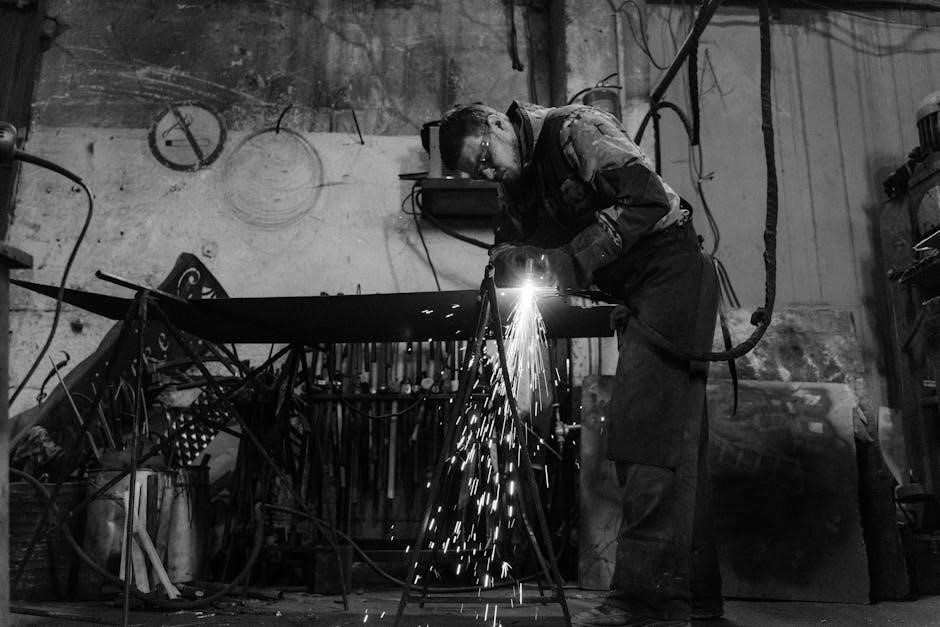The AISC Steel Construction Manual is the premier reference for structural steel design and construction in the United States, trusted by engineers and architects for decades. First published in 1927, it provides comprehensive guidance on steel design, fabrication, and erection, reflecting the latest industry standards and practices. Updated regularly, the manual ensures compliance with current codes, including the AISC 360 Specification, and serves as an indispensable resource for professionals seeking safe and efficient steel specifications and codes.
Overview of the AISC Steel Construction Manual
The AISC Steel Construction Manual is a comprehensive guide for structural steel design, fabrication, and erection, widely regarded as the primary reference in the U.S. Updated regularly, it incorporates the latest advancements in steel construction, including the AISC 360 Specification for Structural Steel Buildings. The manual provides detailed design specifications, examples, and practical applications, ensuring compliance with industry standards. It also addresses fabrication tolerances, erection techniques, and quality control measures. Covering topics such as load and resistance factor design (LRFD) and sustainability, the manual is an essential tool for engineers, architects, and contractors involved in steel construction projects.
History and Evolution of the Manual
First published in 1927, the AISC Steel Construction Manual has evolved significantly over the decades, reflecting advancements in structural steel design and construction. Early editions focused on basic steel design principles, while later versions incorporated modern codes and specifications. The 1980s marked a major shift with the introduction of Load and Resistance Factor Design (LRFD), which became a cornerstone of the manual. Recent editions, such as the 15th edition in 2017 and the 16th edition, have updated specifications, design aids, and sustainability practices, ensuring the manual remains a vital resource for the steel construction industry. Its evolution mirrors the growth and innovation of structural steel engineering.
Purpose and Scope of the Manual
The AISC Steel Construction Manual serves as a comprehensive guide for designing and constructing steel structures, offering detailed specifications, codes, and design aids. Its primary purpose is to ensure safe, efficient, and economical steel construction. The manual is tailored for structural engineers, architects, and fabricators, providing clear guidelines for both design and construction processes. It covers a wide range of topics, including material properties, member design, connections, and loads. The manual also includes practical examples and design aids to facilitate accurate calculations and compliance with industry standards. By adhering to its principles, professionals can achieve optimal results in steel construction projects.

Design Specifications and Codes
The AISC Steel Construction Manual provides detailed design specifications and codes, including the AISC 360 Specification for Structural Steel Buildings. It emphasizes Load and Resistance Factor Design (LRFD), offering practical examples and design aids to ensure compliance with industry standards for safe and efficient steel construction.
AISC 360 Specification for Structural Steel Buildings
The AISC 360 Specification for Structural Steel Buildings is a foundational document within the AISC Steel Construction Manual, outlining design requirements for structural steel. It covers Load and Resistance Factor Design (LRFD) principles, ensuring safety and efficiency in steel construction. The specification addresses various steel components, including beams, columns, and connections, providing detailed design provisions. It also includes shear connections and composite member design, ensuring comprehensive guidance for engineers. Regular updates reflect advancements in materials and technologies, making it a critical resource for compliance with modern building codes and standards in the structural steel industry.
Load and Resistance Factor Design (LRFD)
Load and Resistance Factor Design (LRFD) is a design philosophy incorporated in the AISC Steel Construction Manual, emphasizing probabilistic approaches to ensure structural reliability. Unlike traditional Allowable Strength Design (ASD), LRFD uses load and resistance factors to account for uncertainties in material properties and loads. Key elements include load combinations and partial safety factors, ensuring structures can withstand extreme conditions. LRFD promotes efficient material use and is widely adopted for steel construction projects. It aligns with modern engineering practices, providing a balanced approach to safety and economy in structural steel design, as outlined in the AISC 360 Specification.
Design Examples and Applications
The AISC Steel Construction Manual provides detailed design examples that illustrate practical applications of structural steel design principles. These examples cover various components, such as beams, columns, and connections, offering step-by-step calculations and design methodologies. Real-world scenarios, including shear end-plate and single plate shear connections, demonstrate how to apply LRFD principles effectively. The manual also integrates design aids and tables to simplify complex calculations, making it a valuable resource for engineers and students. By focusing on practical applications, the manual bridges the gap between theoretical knowledge and real-world implementation, ensuring efficient and accurate steel structure design. These examples enhance understanding and practical skills in steel construction.

Materials and Standards
The AISC Steel Construction Manual outlines ASTM standards for structural steel, detailing material properties and grades. It includes tables and design aids for selecting appropriate materials, ensuring compliance with latest industry specifications and promoting sustainable steel construction practices.
ASTM Standards for Structural Steel
ASTM standards play a crucial role in defining the properties and requirements of structural steel materials. The AISC Steel Construction Manual references ASTM standards such as A36, A572, and A992, which specify chemical composition, tensile strength, and manufacturing processes. These standards ensure consistency and quality in steel production, enabling engineers to select appropriate materials for their projects. By adhering to ASTM standards, structural steel components meet rigorous safety and performance criteria, ensuring reliability in construction. The manual integrates these standards seamlessly, providing designers with clear guidelines for material selection and compliance with design specifications.
Material Properties and Grades
Material properties and grades are critical in structural steel design, as they define the mechanical and chemical characteristics of steel. The AISC Steel Construction Manual categorizes steel into various grades, such as A36, A572, and A992, each with specific yield strength, tensile strength, and elongation properties. These grades are determined by factors like chemical composition and manufacturing processes. For instance, A36 steel is commonly used for its moderate strength and weldability, while A572 and A992 are preferred for high-strength applications. Understanding material properties and grades ensures proper selection for structural integrity, safety, and compliance with design specifications. This information is essential for engineers and architects.
Sustainability in Steel Construction
Steel construction is increasingly focused on sustainability, with the AISC Steel Construction Manual promoting environmentally responsible practices. Steel is 100% recyclable, making it a highly sustainable material. Modern steel buildings often incorporate recycled steel, reducing the need for virgin materials and lowering environmental impact. Energy efficiency is another key aspect, with steel framing allowing for tighter building envelopes and improved insulation. The manual also aligns with green building standards like LEED, encouraging the use of recycled materials and energy-efficient designs. These practices not only reduce carbon footprints but also support long-term durability and minimal waste, making steel a leader in sustainable construction.

Member Design
The AISC Steel Construction Manual provides comprehensive guidelines for member design, including beams, columns, and composite members, ensuring safe and efficient structural solutions with LRFD principles.
Beam Design and Analysis
The AISC Steel Construction Manual provides detailed guidance for beam design and analysis, focusing on flexural strength, shear capacity, and deflection limits. Load calculations and moment diagrams are essential for determining beam sizing. The manual offers formulas and tables to evaluate allowable stresses and resistances under various loads. Plastic design and elastic analysis methods are covered, ensuring beams meet serviceability and strength requirements; Designers can use LRFD principles to optimize beam sections while adhering to safety factors. The manual also includes examples and design aids to facilitate accurate and efficient beam design, ensuring structural integrity and compliance with current standards. Engineers rely on this resource for practical solutions to complex beam design challenges.
Column Design and Buckling
The AISC Steel Construction Manual provides essential guidance for column design and buckling analysis, addressing axial loads and stability. Design formulas and charts are included to determine axial capacity and evaluate critical buckling loads. Engineers must consider effective lengths, slenderness ratios, and material properties to ensure columns resist compression forces without instability. The manual also covers Euler’s formula for elastic buckling and inelastic buckling for shorter columns. Designers can reference tables for built-up and tapered sections, ensuring compliance with safety factors and load requirements. This section is vital for designing stable and efficient compression members in steel structures, adhering to modern engineering standards.
Composite Member Design
The AISC Steel Construction Manual provides detailed provisions for the design of composite members, combining steel beams with concrete slabs to enhance structural efficiency. Section I of the manual focuses on composite design, offering formulas and guidelines for flexural strength, shear transfer, and load distribution. Engineers can determine the required number and spacing of shear connectors to ensure full composite action. The manual also addresses deflection and vibration considerations for composite floors. Design examples illustrate the application of these principles, emphasizing adherence to safety standards and optimal material use. This section is essential for creating efficient and durable composite steel-concrete systems in modern construction.
Connections and Joints
The AISC Steel Construction Manual provides detailed guidance on designing bolted and welded connections, ensuring structural integrity and safety in steel frames. Shear end-plate and single plate shear connections are emphasized, with design examples and tables like K4.1 offering practical solutions for engineers. The manual also addresses seismic design considerations, ensuring connections withstand lateral forces. Proper joint detailing is highlighted to optimize fabrication and erection processes, aligning with AISC 360 specifications for reliable and efficient structural performance.
Bolted and Welded Connections
The AISC Steel Construction Manual provides comprehensive design guidelines for bolted and welded connections, ensuring structural integrity and safety. Bolted connections are detailed with emphasis on proper bolt types, tightening procedures, and load transfer mechanisms. Welded connections are addressed with focus on weld types, sizes, and inspection criteria. The manual includes design examples, such as shear end-plate and single plate shear connections, supported by tables like K4.1. Seismic design considerations are also covered to enhance connection ductility. These guidelines ensure engineers can design efficient and reliable joints, aligning with AISC 360 specifications for safe and durable steel structures.
Shear End-Plate and Single Plate Shear Connections
The AISC Steel Construction Manual details shear end-plate and single plate shear connections, essential for transferring loads in steel structures. Shear end-plate connections are analyzed for their ability to resist shear forces, with design checks focusing on plate thickness and bolt placement. Single plate shear connections are examined for their efficiency in beam-to-column joints, emphasizing plate size optimization. The manual provides formulas and tables, like Table K4.1, to facilitate accurate design calculations. These connections are critical in ensuring structural stability, particularly under seismic loads, and the manual offers practical examples to guide engineers in their application, adhering to AISC 360 specifications.
Seismic Design Considerations
The AISC Steel Construction Manual emphasizes seismic design considerations to ensure structural resilience in earthquake-prone areas. It focuses on energy dissipation, load transfer, and ductility in steel frames. Seismic design requires careful detailing of connections and members to maintain structural integrity under cyclic loading. The manual provides specific provisions for moment connections, bracing systems, and column bases, ensuring compliance with modern seismic standards. Designers are guided on stability checks, material selection, and detailing requirements to enhance seismic performance. These considerations are integral to creating structures that can withstand seismic forces while maintaining safety and minimizing damage.
Loads and Load Combinations
The AISC Steel Construction Manual addresses gravity, lateral, wind, and seismic loads, providing guidelines for load combinations and factors to ensure structural integrity and safety in steel buildings.
Gravity and Lateral Loads
Gravity loads, including dead and live loads, act vertically, while lateral loads, such as wind and seismic forces, act horizontally. The AISC Manual provides detailed guidance on calculating these loads, combining them according to ASCE 7 standards, and applying load factors to ensure structural safety. Load combinations are critical to determine the maximum demand on steel members and connections. The manual also addresses load distribution and transfer mechanisms, ensuring efficient and reliable designs. By adhering to these guidelines, engineers can design steel structures that withstand various load conditions while maintaining safety and efficiency.
Load Combinations and Factors
Load combinations and factors are essential in structural steel design to ensure safety and reliability. The AISC Steel Construction Manual specifies load combinations, such as dead, live, wind, and seismic loads, which must be considered together. Load factors account for uncertainties in load magnitudes and material behavior. For example, gravity loads are combined with lateral loads using specific multipliers to ensure the structure can resist the most critical condition. The manual provides tables, such as Table 1.1 and Table 1.2, that outline these factors, aiding engineers in designing structures that meet safety and performance requirements under various load scenarios.
Wind and Seismic Load Design
Wind and seismic load design are critical components of structural steel construction, ensuring buildings withstand natural forces. The AISC Steel Construction Manual provides detailed provisions for analyzing and designing structures under wind and seismic loads. Wind loads are calculated based on speed, pressure, and building height, while seismic loads consider earthquake magnitude, soil type, and structural dynamics. The manual offers design guidelines, including load combinations and material specifications, to ensure resilience. Advanced analysis methods, such as dynamic analysis for seismic design and wind tunnel testing for precise load determination, are also addressed. These provisions help engineers create safe, durable structures that meet performance requirements.

Fabrication and Erection
Fabrication and erection are key steps in steel construction, ensuring precise assembly of structural components. The manual outlines fabrication tolerances, best practices, and erection techniques to ensure safety and structural integrity.
Fabrication Tolerances and Practices
Fabrication tolerances and practices are critical to ensuring structural steel components meet design specifications. The manual establishes allowable tolerances for cutting, drilling, and assembly to maintain dimensional accuracy. Proper calibration of equipment and adherence to standardized practices are emphasized to minimize defects. Key considerations include mill tolerances, material preparation, and welding procedures. Fabrication practices must align with project specifications and industry standards to ensure compatibility and safety. Regular quality control checks are essential to verify compliance and address deviations promptly. These guidelines help fabricators produce high-quality components, ensuring the integrity and performance of the final structure. Adherence to these practices is vital for project success.
Erection Techniques and Safety
Erection techniques and safety are paramount during steel construction to ensure structural integrity and worker well-being. The AISC manual outlines best practices for erecting steel components, emphasizing proper sequencing, crane operations, and rigging. Safe handling and placement of beams and columns are critical to prevent accidents and ensure alignment with design specifications. Workers must adhere to safety protocols, including the use of personal protective equipment (PPE) and fall protection systems. Regular inspections of equipment and rigging are essential to maintain safety standards throughout the process. Proper communication and coordination among the erection team are also vital to achieve a safe and efficient operation.
The manual also addresses potential hazards, such as unstable loads or improper bolting, which can lead to structural instability. By following established erection procedures and safety guidelines, professionals can minimize risks and ensure a successful project outcome. Compliance with these practices is non-negotiable for maintaining a secure working environment and delivering a durable structure. Regular safety training and inspections further reinforce these standards, ensuring all parties involved are aligned with best practices.
Quality Control and Inspection
Quality control and inspection are critical to ensuring the structural integrity and safety of steel constructions. The AISC manual outlines detailed inspection criteria for all stages of construction, from material delivery to final assembly. Inspection checklists are provided to verify compliance with design specifications, ensuring that all components meet required standards. Regular inspections help identify and address potential defects early, preventing costly rework. Documentation of inspection results is essential for maintaining transparency and accountability. By adhering to these quality control measures, professionals can ensure that the final structure is safe, durable, and compliant with all relevant codes and standards.
Corrective actions for defects, such as welding repairs or replacement of non-conforming materials, are also detailed in the manual. This systematic approach to quality control ensures that every aspect of the construction process aligns with industry best practices and safety protocols.

Inspection and Testing
Inspection and testing are essential for ensuring structural integrity and compliance with AISC standards, covering non-destructive testing methods and detailed checklists to verify material and construction quality.
Non-Destructive Testing Methods
Non-destructive testing (NDT) methods are critical for verifying the integrity of steel components without causing damage. Common techniques include ultrasonic testing, magnetic particle testing, and visual inspections. These methods help detect defects, such as cracks or weld imperfections, ensuring compliance with AISC standards. Advanced NDT tools enhance accuracy and efficiency, supporting quality control in steel construction projects. Regular inspections are essential for maintaining structural safety and durability, aligning with ASTM guidelines and industry best practices.
Inspection Checklists and Criteria
Inspection checklists and criteria are essential for ensuring compliance with AISC standards and maintaining structural integrity. These checklists outline specific inspection tasks, such as verifying weld sizes, bolt tensions, and material grades. Criteria are based on ASTM guidelines and AISC 360 specifications, ensuring all components meet design requirements. Inspectors document findings, identifying defects or deviations for corrective action. Proper documentation and adherence to these criteria minimize risks and ensure quality control throughout the construction process. Regular inspections are critical for maintaining safety and durability in steel structures, aligning with industry best practices and regulatory standards.
Corrective Actions for Defects
Corrective actions for defects in steel construction are critical to ensure structural integrity and safety. The AISC Steel Construction Manual outlines procedures for addressing defects, such as weld repairs or component replacement. Defects are categorized by severity, with critical issues requiring immediate attention. Repair methods must comply with AISC and ASTM standards, ensuring materials and techniques meet specified requirements. Documentation of defects and corrective actions is essential for quality control and compliance. Inspectors approve repairs to guarantee safety and adherence to design specifications. Proper corrective measures prevent potential failures and maintain the durability of steel structures, aligning with industry best practices and standards.
Sustainability and Environmental Considerations
Steel construction emphasizes sustainability through recycling, energy efficiency, and reduced material waste. The AISC Manual promotes environmentally responsible practices, aligning with LEED standards and green building initiatives.
Recycling and Reuse of Steel
Steel is one of the most recycled materials globally, with a high rate of reuse in construction. The AISC Steel Construction Manual highlights steel’s recyclability as a key sustainability advantage. Recycling steel reduces the need for virgin materials, conserves resources, and lowers energy consumption. The manual encourages designing structures for deconstruction, enabling the reuse of steel components. This approach minimizes waste and supports circular economy principles. By promoting recycling and reuse, the manual aligns with environmental goals and green building standards, making steel a preferred choice for sustainable construction projects.
Energy Efficiency in Steel Buildings
Steel buildings offer significant opportunities for energy efficiency, as highlighted in the AISC Steel Construction Manual. Steel’s high strength-to-weight ratio allows for lightweight yet durable structures, reducing material usage and energy consumption. The manual emphasizes techniques such as optimizing member sizing and utilizing high-strength steels to minimize thermal bridging and improve insulation performance. Additionally, steel’s adaptability enables the integration of energy-efficient systems, such as solar panels and green roofs. By aligning with LEED and green building standards, steel construction supports sustainable design, lowering operational energy costs and reducing carbon footprints while maintaining structural integrity and aesthetic appeal;
LEED and Green Building Standards
The AISC Steel Construction Manual aligns with LEED and green building standards, promoting sustainable steel construction practices. Steel’s recyclability and durability contribute to earning LEED credits, particularly in categories like Material and Resources and Energy and Atmosphere. The manual highlights how steel framing can minimize waste and reduce environmental impact. By specifying high-recycled-content steel and optimizing structural systems, projects can achieve higher LEED certification levels. Additionally, the manual provides design aids and examples that support energy-efficient building envelopes and renewable energy integration, helping architects and engineers meet rigorous green building standards while maintaining cost-effectiveness and structural performance.

Case Studies and Practical Applications
The AISC Steel Construction Manual features case studies highlighting real-world applications, providing insights into successful steel projects, practical design solutions, and lessons learned.
Real-World Examples of Steel Construction
The AISC Steel Construction Manual provides practical insights through real-world examples, showcasing successful steel projects like high-rise buildings, bridges, and industrial facilities. These examples demonstrate how steel’s strength, durability, and versatility are leveraged in diverse applications. The manual highlights innovative solutions, such as the use of shear end-plate and single plate shear connections, and shares lessons learned from complex projects. By integrating design aids and updated standards, the manual enables engineers to apply proven methodologies to real-world challenges, ensuring safe and efficient steel construction practices across various industries. These case studies serve as valuable benchmarks for professionals in the field.
Lessons Learned from Steel Projects
Steel projects documented in the AISC Steel Construction Manual offer valuable lessons, emphasizing the importance of adhering to design specifications and codes. Case studies reveal common challenges, such as material selection and connection design, and provide solutions. For instance, the manual highlights the significance of proper bolted and welded connections, citing examples where design flaws led to structural issues. It also underscores the role of non-destructive testing in ensuring quality. These lessons stress the need for rigorous quality control and adherence to standards like ASTM and AISC 360. By learning from past projects, engineers can avoid costly mistakes and improve future designs.
Innovative Steel Design Solutions
The AISC Steel Construction Manual highlights innovative steel design solutions that push the boundaries of structural engineering. Advanced techniques like the intermeshed steel connection (ISC) offer enhanced performance in gravity frames. Robotic fabrication and 3D printing are revolutionizing steel construction, enabling complex geometries. The integration of AI and BIM streamlines design processes, improving accuracy and efficiency. Sustainable practices, such as recycling steel and optimizing material use, are also prioritized. These innovations not only meet modern design challenges but also align with green building standards, ensuring steel remains a cutting-edge material for future construction projects. The manual serves as a catalyst for these advancements, guiding engineers toward smarter solutions.

Future Trends in Steel Construction
Advancements in steel materials and technology, integration of AI and BIM, and emerging codes are reshaping the industry, enabling smarter, sustainable, and more efficient construction practices globally.
Advancements in Steel Materials and Technology
Recent advancements in steel materials and technology are transforming the construction industry. High-strength, lightweight steel alloys are being developed to improve structural efficiency and reduce material usage. Novel manufacturing techniques, such as 3D printing and advanced rolling processes, enable complex shapes and customized designs. Additionally, sustainable steel production methods are gaining traction, reducing environmental impact. These innovations, combined with updates in the AISC Steel Construction Manual, ensure that steel remains a leading material in modern construction, offering enhanced performance, durability, and environmental benefits for future projects.
Integration of AI and BIM in Steel Design
The integration of Artificial Intelligence (AI) and Building Information Modeling (BIM) in steel design is revolutionizing the industry. AI algorithms optimize structural analysis and design processes, improving accuracy and efficiency. BIM software enables real-time collaboration and precise modeling, reducing errors and enhancing project visualization. By combining these technologies, engineers can automate repetitive tasks, streamline workflows, and achieve faster project delivery. The AISC Steel Construction Manual supports these advancements by providing updated design aids and specifications, ensuring seamless integration with AI and BIM tools. This synergy between technology and standards is driving innovation and setting new benchmarks in steel construction.
Emerging Codes and Standards
Emerging codes and standards in steel construction are shaping the future of the industry. The AISC Steel Construction Manual incorporates the latest updates from organizations like ASTM and the International Building Code (IBC). New standards focus on sustainability, resilience, and advanced materials. For instance, updates to the AISC 360 Specification address high-performance steel grades and seismic design improvements. These changes ensure that steel structures meet evolving safety and environmental requirements. Professionals must stay informed about these updates to maintain compliance and deliver innovative, durable designs. The manual serves as a critical resource for navigating these advancements and implementing them effectively in practice.
